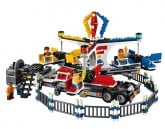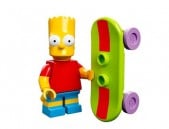Latest Gear Live Videos
Monday August 13, 2007 11:29 pm
California Extreme Channels a Simpler Time

Gamers of a certain age, if given half a chance, will gladly recount grand tales of smoky rooms, dimly lit by a few dozen cathode rays where the only sounds are the white noise of competing digitized soundtracks, crude speech sythesizers, blips and bells, pings and whistles and artificial arpeggios rolling down an electronic scale.
The misty sincerity of those gamers who cut their teeth on the quarter-munching cabinets of Space Invaders, Asteroids, Missile Command and Sinistar is almost enough to make one forget what a mess the modern arcade equivalent has become. The gargantuan interface machines with their elaborate weapon approximations and physical demands juxtapose over a likewise spectacular price per play resulting in a hollow shell of what the old guard knew so well. These are not arcades as exist in those guarded memories, they are interactive entertainment experiences: The kind of branded, marginalized speciality device that has been focus tested and trade-show marketed to get the premium floor space right out front in view of the mall concourse is showpiece here.
Even those arcade machines which can still accurately be described as video games compete for the higher-yield ticket-generating skill games (which ironically involve very little skill). Most of those who recall the days when 3D graphics referred to the vector lines of Tempest pass by these modern emporiums. Perhaps they shake their heads a little or make a disparaging comment. Kids these days. Get off my lawn. They don’t enter; inside is only heartbreak.
Perhaps what hurts the most is that it is a heartbreak we chose. We have no one to blame but ourselves, for while the arcade as it was may be dead, ultimately it is us who killed it.
We wanted the more valuable entertainment experience. We asked for and then demanded a perfect replica of our arcade favorites that we could play at home from the comfort of our couches. We pressed for more arcade-quality graphics on our home consoles until our set top boxes had visuals that outpaced anything showcased on a standalone machine. We asked for, and received, greater narrative depth in our games and as a casualty for our insistence we killed the arcade—the very entity we now mourn.
It could be argued that the evolution of the video game from the precepts of the pay-for-play cabinet in a social or semi-social environment is a positive thing: A step for a medium and an industry akin to the introduction of the “talkie” in cinema. For a brief period of time, silent films ruled and that was all that was known: In that interim actors approached their jobs differently than they would, eventually. Directors and technicians focused on a set of challenges that were but a subset of the factors involved in a full blown picture-and-sound spectacular. Audiences, too, were forced to experience the result in a fresh and unfamiliar way, but a way that they preferred.
The fact that silent movies are not inherently inferior to films with sound suggests that likewise gamers not need feel that just because the world and the industry and the audience has moved on or grown up or shifted direction that those marvelous machines they recall so fondly are suddenly valueless. Perhaps it is too soon to be evaluating arcade machines in a fully historical context, but there is history there, and legacy. Most importantly, there is fun there even now and that’s what it really is all about.
Mercifully the people behind the annual California Extreme exposition understand all of this. Each year they gather gaming enthusiasts from all walks of life, bring together arcade collectors and pinball tinkerers to show off their games and invite the public to come and enjoy them all for as long as they can remain standing.
When you enter the hall, the dim light immediately harkens those heady days of misspent youth where a pocketful of quarters and an afternoon seemed to last forever and yet disappear in a moment. That white noise din and the soothing electric glow washes over like a treasured blanket. It feels like home.
For some, you can tell this is a time machine. And the conventioneers understand this as well, selling memorabilia T-shirts and playing 80s pop and rock songs to simulate a distantly familiar jukebox you once knew so well. That it now runs the equivalent of 400 jukeboxes on an iPod the size of a deck of cards is hardly the point, the motive is the atmosphere and it might as well be a flux capacitor sucking 1.21 jigawatts. The effect is, temporarily, dizzying.
Others who scamper the long rows of soldier-like machines find this to be anachronistic, like visiting a farm or an Amish community where butter is still churned and eggs are fetched from beheath a chicken rather than beneath a lid of polystyrene. Perhaps at first they don’t understand but soon they will, as they find the dual joystick controls of Robotron reminiscent of Super Stardust HD and the face-front outlines of their X-Wing in Star Wars so clearly the precursor to Rogue Squadron. They may be young but they sense the vitality that so many of the titles held dear by the veteran arcade gamers find so precious. Fortunately, our memories (for the most part, with exceptions for Space Ace) are true and these games do have soul and vigor. It can’t be properly defined but as with the very best titles we play today in our fancy machines brimming with gigabytes and rapidly processed packets of globe-spanning data zipped effortlessly through the air you can still feel the hand of a creative person, butting heads with technology’s edge and trying desperately to show you why you really need to destroy every last one of these freaky aliens.
As they drift from one device to the next, examining the ancient pinball machines whose backboxes depict buxom women draped over their sturdy protectors, the people find wonder or solace or nostalgia or curiosity. For a moment, this is gaming as it ought to be: A physical multiplayer matchmaking service where your interface protocol is a handshake or a head nod, where the flame wars are courteous conversations about which version of Galaga is superior and the resolution is, “Heck with it, they’re all good, let’s go grab some ice cream.” It is in the span of this weekend that the guy who always had the top score on the Donkey Kong cocktail cabinet at the local pizza parlor will experience DDR and a young man folds up his Nintendo DS so he can take a turn at Zaxxon. For only two days, the year is 1982, we are all 14 and arcades aren’t dead, they’re only hibernating. Look, here they are, just where we left them. And see?
They’re all set to Free Play.
- Related Tags:
- arcade, asteroids, california, california extreme, ddr, donkey kong, galaga, gamers, games, gaming, history, memories, missile command, nostalgia, people, pinball, retro, robotron, sinistar, space invaders, star wars, tempest, zaxxon
Advertisement
Advertisement
Advertisement
© Gear Live Media, LLC. 2007 – User-posted content, unless source is quoted, is licensed under a Creative Commons Public Domain License. Gear Live graphics, logos, designs, page headers, button icons, videos, articles, blogs, forums, scripts and other service names are the trademarks of Gear Live Inc.












Comments: